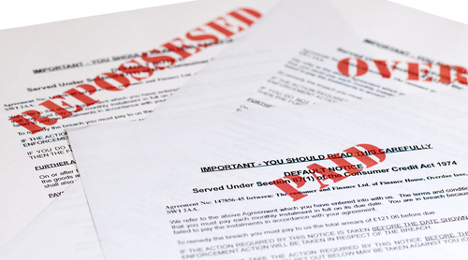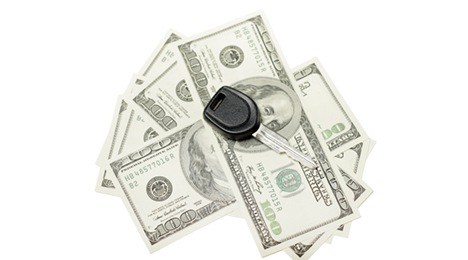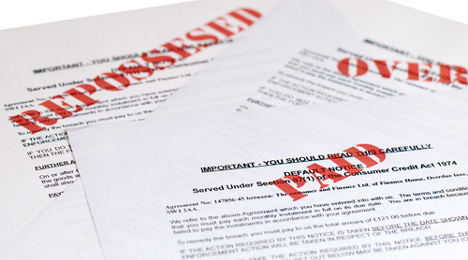Auto loans defaults stayed the same level on a sequential basis in November, according to the S&P/Experian Consumer Credit Default Indices released this week.
S&P Dow Jones Indices and Experian determined the auto default reading came in at 1.05 percent last month, the same level as October. A year earlier, the reading stood 10 basis points higher at 1.15 percent.
The national composite rate — a comprehensive measure of changes in consumer credit defaults — continued to show an increase in default rates in November, as it ticked up 1 basis point from October to 1.07 percent.
For the fourth consecutive month, the first mortgage default rate rose 1 basis point to 0.97 percent in November.
The second mortgage default also increased 1 basis point from its historical low in October to 0.48 percent.
Analysts highlighted that the bank card rate set a new historical low again in November with a reported rate of 2.59 percent, down 1 basis point from the previous month.
“The composite default rate continues to show very little movement, remaining close to one percent. The default rate on autos is up slightly from last summer's low but below levels of a year earlier,” said David Blitzer, managing director and chairman of the index committee for S&P Dow Jones Indices.
“Default rates for bank credit cards are at their lowest levels since the series began in 2004 while first mortgage defaults are up very slightly from summer lows,” Blitzer continued.
“Key economic factors favor the consumer: oil and gasoline prices are down, debt services ratios — the proportion of income the average house uses to cover debt payments — are close to record lows, inflation is low and the economy is finally seeing hints of wage growth,” he went on to say.
Looking at the five largest U.S. cities analysts track for this monthly report, Chicago, Los Angeles and New York all posted default rate decreases in November.
In fact, the Windy City generated a default rate of 1.11 percent — a new historical low — while Los Angeles decreased 1 basis points to 0.80 percent.
In the Big Apple, the rate ticked lower for the fourth month in a row, leaving New York rate for November at 0.98 percent.
Conversely, Dallas and Miami both endured default rates increase in November. Dallas came in at 1.03 percent while Miami’s rate spiked 20 basis points higher from October’s reading to land at 1.46 percent.
“Despite the recent trend, all five cities — Chicago, Dallas, Los Angeles, Miami and New York — still remain below rates seen a year ago,” Blitzer said.
Jointly developed by S&P Indices and Experian, Blitzer reiterated the S&P/Experian Consumer Credit Default Indices are published monthly with the intent to accurately track the default experience of consumer balances in four key loan categories: auto, bankcard, first mortgage lien and second mortgage lien.
The indices are calculated based on data extracted from Experian’s consumer credit database. This database is populated with individual consumer loan and payment data submitted by lenders to Experian every month.
Experian’s base of data contributors includes leading banks and mortgage companies and covers approximately $11 trillion in outstanding loans sourced from 11,500 lenders.
Black Book vice president of data licensing Jared Kalfus described the industry “crossroads” finance company executives are assessing based on his first-hand conversations at last month’s Used Car Week in Las Vegas.
What has finance company leadership pondering which way to turn at this “crossroads?” Analysts from firms such as Black Book and TransUnion are finding that loan-to-value ratios are strong indicators for severity of loss. They say the lower a vehicle’s equity position, the lower the loan recovery rate and the higher the severity of loss.
“If we look back historically, lenders have used more traditional risk measurements, including credit score, time to maturity and the size of the loan. And when you observe these loans on paper just by looking at them, many look the same until the vehicle equity position is truly factored in and considered,” Kalfus told SubPrime Auto Finance News during a recent phone interview.
“When you start to consider the equity position that vehicle might have, that’s when you really start to underscore the fact that vehicle values are a critical component when evaluating these individual loans and portfolios,” he continued.
In analyzing more than 800,000 loans, a recent study with TransUnion showed that there is a strong correlation between LTV ratios and frequency of loss.
As an example, in looking at two loans that each had a balance of $7,500, a customer credit score of 720, and 24 months to maturity, one vehicle was valued at $12,500, and a second was valued at $4,500. The study showed that the latter loan will, in fact, default more frequently.
Black Book vice president of analytics Anil Goyal indicated the study results showed that finance companies that tracked LTVs closely enjoyed a “significant lift in predicative power by using equity in the whole process.
“That can give an edge to lenders. More accurate prediction of delinquency and default can help in better loss forecasting, better prioritization of collection activities and better forecasting of repayment rates,” Goyal continued.
Goyal added that watching LTVs is especially important as Black Book anticipates the decline of its vehicle value index after 36 months of record high levels.
“This is really important from a lending perspective because the vehicle value trends are all evolving,” Goyal said. “Early in the year in the spring, we saw the compact car segment for example was very strong, and now that segment is under pressure.
“On the other hand, now we’re seeing full-size SUVs and pickups are retaining their values here late in the year when usually we see a steeper depreciation,” he continued.
“The takeaway for the lenders is really to have a balanced portfolio and monitor the collateral values with accurate data and use that in their predicative models on a regular basis so they can have an edge,” Goyal went on to say.
That edge is part of why Kalfus mentioned that he saw the “crossroads” appear again during Used Car Week. Kalfus shared that he was having a conversation with a finance company executive who was quite familiar with the recent analysis by Black Book and TransUnion and recently implemented the LTV metric into its ongoing portfolio analysis. An executive from a different finance company overhead the discussion and joined in because he wanted to know more about to integrate LTV data into risk mitigation.
Kalfus acknowledged the finance company executive familiar with the data basically took over the pitch the Black Book VP typically makes, creating a “pleasant surprise.”
Kalfus continued, “The more data that finance companies use, the more predicative they will be, the more on top of their portfolios they will be. They can work to mitigate their risk.
“Our takeaway to reinforce the message in the conversation we’ve been having with lenders in the automotive finance community is that collateral values have a critical role in the overall underwriting, risk mitigation, and ultimately, long-term portfolio management,” he went on to say. “If they start to incorporate these traits and characteristics into their every-day portfolio management, then they’ll not only have more profitable portfolio, they’ll reduce their risk.”
And Goyal pointed out that finance companies can integrate LTV analysis into their portfolio management strategy in the same way they might watch credit scores.
“They’re all using similar techniques in terms of regression analysis to factor in whatever data they can get, whether it’s from the credit bureau or alternative data providers. Using equity in the whole mix can give you an edge,” Goyal said.
“When I talked to lenders, they are anticipating an uptick in delinquency, and that doesn’t scare them because the delinquency levels are pretty low,” he continued. “What they are concerned about is the vehicle valuations, where they’re going to be next year. What we’re seeing is there’s a lot more volatility across the different segments. They’re not all moving the same way. Some segments are dropping faster; some are not.
“That factor is what going to be important in assessing where your portfolio is moving,” Goyal went on to say. “Is your portfolio continuing to be balanced? Are you tracking your portfolio to determine where your risks are and using that data to prioritize where you want to work?”
Perhaps that’s why Kalfus indicated the industry is at a “crossroads.”
Kalfus closed his comments to SubPrime Auto Finance News by emphasizing, “Lenders are really more engaged.”
TransUnion explained why a rise in delinquencies within the subprime segment of the auto financing market reflects a “healthy” condition.
Analysts indicated the subprime delinquency rate — those consumers with a VantageScore 3.0 credit score lower than 601 — increased from 4.50 percent in the third quarter of last year to 5.31 percent in the third quarter of this year.
TransUnion also pointed out the share of non-prime, higher risk loan originations — with a VantageScore 3.0 credit score lower than 661 — grew by 14 basis points from 36.39 percent in Q2 of 2013 to 36.53 percent in Q2 2014. The credit bureau mentioned this percentage is higher than what was observed five years ago near the end of the recession when it stood at 31.67 percent in Q2 2009.
For finance company executives and industry observers who might be thinking that any type of delinquency rise is cause for alarm, TransUnion automotive vice president Peter Turek described his thinking when the credit bureau released its latest data on Monday.
“We’ve been at an elevated state of subprime originations for several quarters, and the good news is that there has not been a material impact on the overall auto loan delinquency rate,” Turek said.
“The uptick in delinquency reflects a healthy and thriving auto finance industry where credit is more broadly available to all consumers,” he continued.
The delinquency rate not only climbed in the subprime space, but TransUnion also noticed it moved higher year-over-year when looking at the entire market, too.
Analysts determined auto loan delinquency rates jumped nearly 13 percent in the last year to close Q3 2014 at 1.16 percent. At the same time, auto loan debt rose for the 14th straight quarter to $17,352.
The latest TransUnion auto loan report also found that delinquency rates increased most for the youngest population subset with those under the age of 30 seeing a nearly 18-percent rise.
The data provided is gathered from TransUnion's proprietary Industry Insights Report (IIR), a quarterly overview summarizing data, trends and perspectives on the U.S. consumer lending industry. The report is based on anonymized credit data from virtually every credit-active consumer in the United States.
The auto loan delinquency rate (the ratio of borrowers 60 days or more delinquent on their auto loans) increased to 1.16 percent in Q3 2014, up from 1.02 percent in Q3 2013. Auto loan delinquencies also experienced a quarterly increase due to seasonality from 0.98 percent in Q2 2014, according to the credit bureau’s data.
“The auto loan delinquency rate is rising, but it remains well below levels observed just a few years ago,” said Turek, who was one of the many experts on hand during the SubPrime Forum at Used Car Week.
“With nearly 5 million more auto loan accounts reported in the last year and with continued sales strength in this sector, it’s not unusual to see an increase in the delinquency rate,” he continued.
“As long as delinquency rates remain around 1 percent, we don’t anticipate seeing a material change in auto lending strategies,” Turek went on to say.
Analysts discovered all but two states — Hawaii and Oklahoma — experienced an increase in their auto loan delinquency rates between Q3 2013 and Q3 2014. The largest delinquency increases occurred in Nebraska, South Carolina and New Mexico.
TransUnion's analysis also found that auto loan delinquency rates increased across all age groups.
Auto loan debt per borrower rose 3.9 percent from $16,694 in Q3 2013 to $17,352 in Q3 2014. On a quarterly basis, auto loan debt increased 1.4 percent from $17,108 in Q2 2014.
Auto loan balances rose in every state between Q3 2013 and Q3 2014. Among the largest U.S. cities, Phoenix, Atlanta and Chicago saw the largest yearly auto loan debt rises of approximately 5 percent, according to analysts.
TransUnion recorded 64.2 million auto loan accounts as of Q3 2014, up from 59.4 million in Q3 2013. Viewed one quarter in arrears (to ensure all accounts are included in the data), new account originations increased to 6.93 million in Q2 2014, up from 6.55 million in Q2 2013.
More subprime paper in finance company portfolios nowadays is continuing to push delinquencies higher.
Experian Automotive determined both 30- and 60-day auto loan delinquencies climbed during the third quarter of 2014. According to its latest State of the Automotive Finance Market report, 30-day delinquencies grew 3.7 percent from the previous year.
Similarly, 60-day delinquencies jumped 8.6 percent during the same time period.
“While we have observed a rise in delinquencies over the past few quarters, it was to be expected due to the growth in subprime loans. We have to keep in mind that a majority of the market is still in the prime risk category,” said Melinda Zabritski, Experian’s senior director of automotive credit who gave a preview of this data when she conducted the opening session of the SubPrime Foum at Used Car Week in Las Vegas.
“As long as consumers continue to do a good job of making their auto-loan payments on time and lenders keep a close eye on how rates fluctuate year over year, the industry should remain relatively stable,” Zabritski continued.
“Understanding the shifts in payment behavior and the industry’s risk tolerance are important for the market because these insights can trigger actions that affect vehicle prices, loan terms or interest rates,” she went on to say.
As top players in the subprime space already might have surmised, further findings from the report showed that states in the South accounted for four of the top five highest delinquency rates in both the 30- and 60-day category.
On the flip side, the states with the lowest delinquency rates in both categories primarily resided in the Midwest and Northwest regions.
30-day Delinquency Rates by State
Highest
Delinquency Rate |
|
Lowest
Delinquency Rate |
|
| Mississippi |
4.49% |
North Dakota |
1.18% |
| Washington D.C. |
4.02% |
South Dakota |
1.43% |
| Louisiana |
3.71% |
Minnesota |
1.49% |
| South Carolina |
3.66% |
Oregon |
1.50% |
| Alabama |
3.49% |
Alaska |
1.54% |
60-day Delinquency Rates by State
Highest
Delinquency Rate |
|
Lowest
Delinquency Rate |
|
| Washington D.C. |
1.42% |
North Dakota |
0.27% |
| Mississippi |
1.36% |
Alaska |
0.36% |
| Louisiana |
1.16% |
Oregon |
0.37% |
| Alabama |
1.05% |
South Dakota |
0.42% |
| New Mexico |
1.01% |
Idaho |
0.42% |
Other findings from Experian latest report include:
• Total balances for all open automotive loans grew to $870 billion, up from $784 billion a year ago.
• Finance companies saw the highest percentage increase in total dollar volume, jumping 19.6 percent to $134 billion.
• Super-prime loans accounted for 20.6 percent of total loans in Q3 2014, up from 20.26 percent the prior year. At the opposite end of the spectrum, deep subprime grew from 3.57 percent to 3.84 percent.
It’s not necessarily the volume of auto loans that commercial banks are generating that has the Office of the Comptroller of the Currency (OCC) troubled. It’s the volume of paper that has defaulted and been charged off that has bank regulators concerned.
During a speech on Tuesday, Darrin Benhart, the OCC’s deputy comptroller for credit and market risk, highlighted how much charge-offs among banks grew in a 12-month span. Benhart indicated the average charge-off for a defaulted auto loan increased from $6,832 in the fourth quarter of 2012 to $7,618 in the fourth quarter of 2013.
“That’s a 12-percent increase in 12 months,” Benhart told attendees at the 22nd annual Financial Services Collections & Operational Risk Conference in Las Vegas.
Benhart explained the data came from the OCC’s Semiannual Risk Perspective, a report generated twice a year in an effort to inform the industry about emerging risks. The most recent installment came in June, and Benhart said a new offering is to be published before the end of the year.
Benhart acknowledged the June report covers a number of risks, but he focused part of his appearance on auto financing.
“Auto lending, as pointed out in the report, is a bit of a two-edged sword,” Benhart said. “Product structures, loan-to-values and pricing practices raise both credit quality and consumer compliance concerns. Increased wealth and improving economic conditions have improved consumers’ confidence and drawn them back to auto showrooms and car lots.
“The result is a double-digit growth in this product at many of our banks. That healthy growth reflects the consumer appetite for new, or ‘new-to-you’ cars that families may have decided not to purchase in previous years when unemployment was higher and the overall economy more sluggish,” he continued.
Benhart noted that total outstanding auto loans in national banks and federal thrifts grew 13 percent in 2013 and expanded by another 4.8 percent through June 30 of this year. He also pointed out some individual banks that concentrate in vehicle financing enjoyed growth rates significantly above that level.
“While that is strong growth, the market remains fragmented with banks, credit unions, finance companies and captives all playing major roles,” said Benhart, adding that banks hold about 29 percent of the total auto finance market. That share equates to about $262 billion in outstanding loans, according to OCC’s analysis.
Benhart stressed the rise in auto financing and its risk stems from one of the same reasons finance company executives often cite when they share quarterly performances.
“Competition is one of the factors behind the increased risk we are seeing,” Benhart said. “Competitive pressure is driving some auto lenders to pursue growth by lengthening terms, increasing advance rates and originating loans to borrowers with lower credit scores. The marketing of these loans is focusing more on monthly payment, with little attention to the overall debt of the borrower.
“Average loan-to-value, or LTV rates for both new and used vehicles are getting more liberal and exceeded 100 percent for all major lender categories at the end of 2013,” he continued. “These high LTVs reflect both rising car prices and a greater bundling of add-on products such as extended warranties, credit life insurance, and aftermarket accessories into the financing.
“The results have yet to show large-scale deterioration at the portfolio level, but we are definitely seeing the signs of increasing risk,” Benhart went on to say.
Benhart insisted the most obvious indicator of increasing risk is that the average loss per vehicle has risen “significantly” during the past 24 months. At this point in his presentation, Benhart mentioned the trend that triggered his concern —that 12-percent rise in charge-offs in 12 months.
“Increased average loss is one indication of how longer terms and higher LTVs can increase exposure. Notably we are seeing average charge-offs in auto lending rise across all lender types over the last year — banks, credit unions, and non-depository finance companies,” he said.
“Some in the media and industry have downplayed the significance of the risk we are identifying in the auto lending industry, but at the OCC, we will continue to monitor product terms and risk layering practices to ensure that banks manage growth and exposure prudently,” Benhart went on to say.
The auto loan default rate reading that’s part of the S&P/Experian Consumer Credit Default Indices climbed in September, marking the fourth time in the past five months it has ticked up slightly on a sequential basis. But analysts also pointed out that September’s reading is just 9 basis points higher than the all-time low registered back in April.
The September auto default level came in at 1.01 percent, which also is 14 basis points lower than a year earlier.
Meanwhile, the national composite rate — what S&P Dow Jones Indices and Experian indicated is a comprehensive measure of changes in consumer credit defaults — stood at 1.04 percent in September, up three basis points from July historical low.
Like the auto loan reading, the national composite rate is well below year-ago levels as the mark in September of last year was 1.38 percent.
Elsewhere, analysts indicated the first mortgage default rate rose for the second consecutive month, leaving the September reading at 0.93 percent. The second mortgage default rate rose one basis point to 0.52 percent, which was its first increase since April.
Analysts added the bank card rate decreased for the third consecutive month, declining by 10 basis points to 2.63 percent.
“Default rates for bank cards reversed an increase seen in the first half of 2014 while defaults on first mortgages and auto loans appear to have bottomed out over the summer. However, none of these movements are very large,” said David Blitzer, managing director and chairman of the index committee for S&P Dow Jones Indices.
“Despite their slight increase, default rates are still near the lows seen before the 2007-2009 recession and financial crisis,” Blitzer said.
Looking at the largest five metropolitan areas S&P and Experian track for this monthly report, Chicago, Dallas, New York and Miami all reported rate decreases.
In fact, Miami recorded a default rate of 1.21 percent, its lowest rate since June 2006. New York registered a default rate of 1.05 percent, the lowest for the Big Apple since September 2005.
Conversely, Blitzer noted Los Angeles had a rate increase for the second consecutive month, coming in at 0.77 percent. That reading is up 11 basis points from the historical low for the City of Angels recorded in July.
“All five cities — Chicago, Dallas, Los Angeles, Miami and New York — remain below default rates seen a year ago,” Blitzer said.
Jointly developed by S&P Indices and Experian, Blitzer reiterated the S&P/Experian Consumer Credit Default Indices are published monthly with the intent to accurately track the default experience of consumer balances in four key loan categories: auto, bankcard, first mortgage lien and second mortgage lien.
The indices are calculated based on data extracted from Experian’s consumer credit database. This database is populated with individual consumer loan and payment data submitted by lenders to Experian every month.
Experian’s base of data contributors includes leading banks and mortgage companies and covers approximately $11 trillion in outstanding loans sourced from 11,500 lenders.
If you set your automated news alerts or RSS feed to “subprime” or “subprime auto finance,” you’re likely to find news stories that fit in one of two camps: A) subprime auto financing is heading down a dangerous path akin to the mortgage crisis of the late 2000s, or B) those fears are perhaps unwarranted.
An analysis from Equifax suggests that case B is the more likely outcome; or as the company suggests in a recap of its National Consumer Credit Trends Report, “a bubble is not occurring in that (subprime auto finance) space.”
“Auto sales continue to soar, crossing the 17.4 million mark on an annualized basis for new cars and light trucks in August,” Amy Crews Cutts, senior vice president and chief economist at Equifax, said in the recap.
“The abundance of high-quality vehicles for sale, the attractive financing options available, and the ever-increasing age of cars on the road today have created an environment that makes it easy for consumers to say ‘yes’ when it comes to purchasing a new or used car,” she added. “Importantly, auto loan originations to borrowers with subprime credit scores remain stable, providing additional evidence that a bubble is not occurring in that space.”
Consider these points shared by Equifax, as reported earlier in SubPrime Auto Finance News.
The total balance of newly originated subprime auto loans stood at $70.7 billion in August, a level representing an eight-year high and 27.8 percent of the total balance of new auto loans. That’s a slight increase in share from the previous year.
However, the credit agency determined serious delinquencies represented 1.05 percent of total balances outstanding in August, a decrease of 8 percent from same time a year ago.
And to Crews Cutts’ point on the stability of origination volume to subprime borrowers, there have been 3.9 million new loans so far this year given to subprime borrowers (Equifax Risk Score of 640 or lower). That comprises 31.2 percent of all auto loan originations, a share that is down slightly year-over-year.
So why, then, has there been so much mainstream media coverage suggesting the opposite?
Gary Hughes, general manager of automotive services for Equifax, said that the coverage has been in reaction to consistent year-over-year gains in new-vehicle sales and “natural inclination” by news outlets has often been to compare it to the real-estate, given how recently that occurred.
“However, I think what we’re seeing is that one of the big issues here is you’ve got a situation that’s very different than the real estate market … there are a couple of elements that we feel are very different from the real estate market,” Hughes told us in a recent interview.
“No. 1 is that even though balances continue to increase on number of loans financed, we’ve seen that you’ve got low interest rates and you’ve got serious delinquency rates that are actually holding and not increasing,” he said. “The amount of due diligence that lenders are being required to do as part of their business practices, as well as what regulatory agencies are requiring of them is also being implemented in these (loans). So, you don’t have the case (similar to) the no-doc mortgages that occurred back in the heyday of the real-estate lending.”
Hughes added: “Also, what you’re finding is that it’s a different type of asset, where the assets — the automobiles — are not depreciating in value or equity at an accelerated rate the way that the real estate market did at the time.”
Given those key differences, Equifax analysts “don’t feel that a bubble or a collapse is imminent,” Hughes said.
More Responsible Lending
When asked if he believes lenders or even borrowers have learned from previous crises or become responsible, Equifax auto finance leader Lou Loquasto pointed to the technology that has allowed lenders to conduct more effective due diligence.
For instance, he mentioned Equifax tools that allow for employer and income verification at the time of approval, assuaging worries over whether or not the customer can repay the loan and decreasing the likelihood of inflated or deflated income stated by the consumer
“They can verify that information upfront, which makes the loan risky at that point,” Loquasto said.
Hughes added: “And there’s more transparency in the process for both the lender and the consumer, which we think is a big difference, as well.”
Vehicle Quality Impact
Going back to one of points of insight from chief economist Crews Cutts, greater volumes of higher-quality vehicles is also playing a role in the credit market.
Hughes noted that vehicles these days go about 11.8 years before they are scrapped. This gives shoppers the chance to find strong-quality cars in various age segments and “degrees of use.”
Brett Collett — strategic account executive for Equifax — pointed out that with the higher volumes of off-lease vehicles amid leasing’s comeback, there are more available cars in the 3-year-old ballpark that are well-maintained.
“When you have a well-maintained car, lenders are more apt to (agree to) extended terms on those,” he said. “The value of the car, as we know, with supply being depressed, has stayed high relatively speaking versus historical.
“With those coming back in, the values will go down a little bit, but again, you won’t see the tremendous drop that you saw in the mortgage area,” Collett added. “And with delinquencies so low, lenders are more apt to be more aggressive and be more competitive with this market.”
Hughes boiled it down like this: the cars are lasting longer, there are a lot coming off lease and being well-maintained, and interest rates are low.
Plus, Hughes added, “With the cars lasting longer, it allows the lenders to write different terms and potentially more aggressive terms. And they’re very comfortable doing that as long as they can be empowered with the information they need to make those smart lending decisions on the candidates and the vehicles, being able to measure some of that vehicle information with the consumer’s information at the time of lending approval.
“That’s what we’re seeing a lot of right now: a real drive to move as much of that information on the consumer’s performance up to the point of application, so that the lenders can make a go/no-go decision early on, and if it doesn’t appear to fit, allowing that dealer to go and fit that consumer into a vehicle and/or a financing package that’s more successful for both of them,” Hughes said.
Upgraded Efforts by Regulators
The point Hughes referred to earlier in this story about ramped-up regulatory efforts on due diligence was particularly evident in an exclusive from Reuters on Sunday.
Citing a “person familiar with the matter,” Reuters said that banks are being prompted by U.S. regulators to provide more information on their exposure in auto finance. The news outlet’s source indicated that in addition to requesting information regarding loans within a respective finance company’s consumer auto lending portfolio, regulators are requesting details on loans given by these companies to fellow auto lenders.
Reuters’ report did not indicate which (or how many) regulatory agency is at the center of these requests, but it did note that there are at least one, according to Reuters’ source.
SubPrime Auto Finance Editor Nick Zulovich contributed to this story.
Analysts for S&P Dow Jones Indices and Experian quickly tempered concerns about a negative payment environment developing even though the auto loan segment of the S&P/Experian Consumer Credit Default Indices ticked up slightly in August.
August’s default rate came in at 1 percent, marginally higher than the previous month’s reading of 0.96 percent. But on a year-over-year comparison, August’s level actually showed a slight decline as the index level a year ago stood at 1.11 percent.
The national composite rate — a comprehensive measure of changes in consumer credit defaults — moved up slightly to 1.03 percent in August, up 2 basis points from the previous month’s historical low.
After nine consecutive months of decline, the first mortgage default rate rose to 0.91 percent while the bank card rate declined 13 basis points to 2.73 percent.
Conversely, the second mortgage default rate dropped 1 basis point to a new historical low of 0.51 percent.
"With the recent and continued growth in the economy, sales of automobiles and existing homes have gained since the start of the year," said David Blitzer, managing director and chairman of the index committee for S&P Dow Jones Indices.
“These factors may be leading to more borrowing and modest increases in default rates. No return to the extreme default experience of a few years ago is imminent,” Blitzer continued.
“Consumer credit default rates rose for the first time since September 2013. Default rates are just above (July’s) historical lows. Auto and first mortgage showed slight increases while bank card continues to trend down,” he went on to say.
Looking at the top five metro areas analysts track for this monthly update, the default rates for Chicago and Dallas remained unchanged at 1.17 percent and 0.80 percent.
Meanwhile, the reading for New York came in at 1.07 percent, the lowest default rate for the Big Apple since July 2006.
“Miami saw its rate decrease to its lowest since August 2006 but still posted the highest default rate of 1.45 percent,” Blitzer said.
Los Angeles was the only city to see its rate increase and continues to maintain the lowest default rate,” he added “All five cities — Chicago, Dallas, Los Angeles, Miami and New York — remain below default rates seen a year ago.”
Jointly developed by S&P Indices and Experian, Blitzer reiterated the S&P/Experian Consumer Credit Default Indices are published monthly with the intent to accurately track the default experience of consumer balances in four key loan categories: auto, bankcard, first mortgage lien and second mortgage lien.
The indices are calculated based on data extracted from Experian’s consumer credit database. This database is populated with individual consumer loan and payment data submitted by lenders to Experian every month.
Experian’s base of data contributors includes leading banks and mortgage companies and covers approximately $11 trillion in outstanding loans sourced from 11,500 lenders.
The Consumer Financial Protection Bureau is insistent that finance companies have documentation verifying the federal compliance of their service providers. For managers that use Allied Finance Adjusters member repossession agencies to find and recover vehicles, a new partnership with Vendor Transparency Solutions is aimed at enhancing what a finance company can show federal regulators.
For some time, AFA maintained its compliance module on its website that assisted its members in sharing compliance documents with finance companies. On Wednesday, AFA and VTS finalized a partnership that designed to take that process many steps higher.
With the introduction of VTS Basic, AFA can now offer our members a platform geared to reach a higher level of compliance. This new software can provide members with more functionality and features, including the VTS Marketing Module, VTS Complaint Handling Module and VTS Continued Education Module to give members exposure to finance companies that utilize VTS Professionals.
“Since the inception of the CFPB, AFA has positioned its members to be the most educated operators in the recovery industry. Working with VTS gives AFA proven tools to show the lending community that AFA and its members are taking compliance seriously,” said James Osselburn, second vice president of Allied Finance Adjusters.
Through the partnership, AFA members can receive exclusive discounts on all VTS services, which consist of VTS Professional, VTS Basic and ongoing continued education.
Additionally, AFA has contracted VTS to perform the site inspections and other due diligence required to become a new member of Allied Finance Adjusters. AFA officials insisted that utilizing VTS to perform these inspections is important when it comes to vetting new members as “the high caliber of VTS will insure to the lending institutions that the members of AFA are held to a higher standard.”
New members of AFA will receive an even greater discount on VTS Basic, should they choose to participate.
Allied Finance Adjusters is one of the leaders among national trade associations in CFPB compliance training and education through its relationship with Recovery Specialist Insurance Group (RSIG). To date, 90 percent of AFA members have completed this training.
Vendor Transparency Solutions president Max Pineiro explained this partnership demonstrates AFA's commitment to be the largest group of bonded, compliant service providers in the nation, which can create new revenue opportunities for members by creating a one-stop shop for all financial institutions, banks, credit unions, law firms and replevin brokers.
Pineiro added the AFA Education Committee will be working closely alongside VTS on its continuing education module to introduce new ideas on education for AFA members and VTS subscribers.
“There is no question that mastering compliance requires a team effort. That team includes the financial institutions, their contracted service providers and the leaders of the industry trade associations that assist their members through valuable tools and benefits,” Pineiro said.
“The most valuable tools today are those that are closely related to compliance and compliance monitoring,” he continued.
“We at VTS applaud Allied Finance Adjusters for taking on the leadership role in the industry and assuring that asset recovery businesses throughout the country have access to the necessary tools needed to achieve compliance," Pineiro went on to say.
Make it 13 quarters in a row during which the average amount consumers had remaining on their vehicle installment contract moved higher year-over-year.
TransUnion's Industry Insights Report indicated that auto loan debt per borrower jumped 4.1 percent from $16,410 in the second quarter of last year to $17,090 in Q2 of this year.
On a quarterly basis, TransUnion reported auto loan debt increased 1.35 percent from $16,862 in the first quarter. TransUnion automotive vice president Peter Turek pointed out that auto loan balances rose in every state year-over-year during the second quarter.
Among the biggest U.S. cities, Houston and Phoenix saw the largest yearly auto loan debt rises of approximately 6 percent. Houston's average auto loan debt increased to $21,690, the highest such number of all major markets.
“The numbers reflect a continued healthy marketplace,” Turek told SubPrime Auto Finance News this week. “There’s competition amongst the manufacturers, auto lenders and dealers. It’s great, healthy competition. I think in the end it benefits all of those stakeholders, especially consumers, the folks who drive those vehicles every day and make the payments.
“What we’re observing is the fact that there is more recent originations,” he continued. “As consumers over the past several quarters have demonstrated, auto sales have been booming and related financing has been booming so we have a lot more auto loans on the books that are recent that have higher balances. That’s what’s driving the higher average balance across all age groups and the industry.
“In addition, when you think about what was going on a couple of years ago, consumers were deleveraging so we were talking about how average balances were going down quarter-over-quarter,” Turek went on to say. “Now we’re in the 13th consecutive quarter where there has been an increase in auto loan debt. I would say that’s primarily from increasing auto sales and more, and more consumers buying automobiles and financing them.”
In a new view of the data, TransUnion also noticed that auto loan debt increases for different age groups remained in a tight range, though changes observed for borrowers ages 40 to 49 were noteworthy. These borrowers saw the largest yearly percentage increase — up more than 5 percent — while also having an average auto loan debt level nearly $1,000 higher than the next age group.
“We’re pleased to offer this slice of data. We think it gives some value around what consumers in different age groups are doing. It’s not really surprising. I think some of it is intuitive. When you think about the ages of people when they’re the most credit active is typically between ages 40 and 60,” Turek said.
TransUnion recorded 62.3 million auto loan accounts as of the second quarter, up from 58.2 million a year earlier. Viewed one quarter in arrears (to ensure all accounts are included in the data), new account originations increased to 6.20 million in the first quarter of this year, up from 5.82 million in the same period last year.
Not Alarmed by Q2 Delinquency Uptick
Auto delinquencies rose slightly in the second quarter because there’s more paper on the streets nowadays, but TransUnion analysts don’t think the trends are necessarily bad for the industry.
According to TransUnion, the auto loan delinquency rate — the ratio of borrowers 60 days or more delinquent on their vehicle installment contracts — increased to 0.95 percent in Q2, up from 0.87 percent a year earlier.
However, TransUnion pointed out that auto delinquencies dropped on a quarterly basis from 1 percent in the first quarter of this year.
Turek explained that the latest delinquency rate remains below the Q2 average of 1.05 percent observed between 2007 and 2014.
Since 2007, Turek noted, the auto loan delinquency rate has reached as high as 1.59 percent (in Q4 2008), while its low was observed in Q2 2012 at 0.86 percent.
"Auto lending remains similar to what we have observed during the last several quarters,” Turek said. “Delinquency rates remain relatively low while auto loan balances keep rising — both metrics aided by increasing auto loan originations.
"In fact, there are 4 million more auto loan accounts in the marketplace than we observed just last year. This means with more auto loans in the marketplace and a delinquency rate ticking higher, we now have several thousand more delinquent accounts than at the midpoint of 2013,” Turek went on to say.
TransUnion indicated that all but six states experienced an increase in their auto loan delinquency rates between Q2 of last year and Q2 of this year. The largest delinquency increases occurred in Alaska, Michigan, Montana and Nebraska.
The largest declines occurred in Hawaii, South Dakota and Oregon.
The subprime delinquency rate (those consumers with a VantageScore 2.0 credit score lower than 641 on a scale of 501-990) increased from 4.12 percent in the second quarter of last year to 4.61 percent in Q2 of this year.
Turek also noted the share of non-prime, higher risk loan originations (with a VantageScore 2.0 credit score lower than 700) grew by 56 basis points (from 33.80 percent in Q1 2013 to 34.36 percent in Q1 2014). This percentage is still lower than what was observed seven years ago near the beginning of the recession (38.98 percent in Q1 2007).
Turek said observers should not read too much into the numbers because “4.61 percent of 1,000 is different than 4.61 percent of 1 million. I’m not suggesting it’s not a reason for concern. But I think when you think about the number of loans that are entering into 30-day delinquency, they’re not flowing through. Even though we still have a low delinquency rate overall, the number of new originations has certainly increased the frequency of delinquency. But we’re not seeing them translate into significant losses.
“As you look at that across the industry, you would interpret that as it’s pretty healthy. People are continuing to buy cars. They’re continuing to finance cars. It seems to be working right now, just in a very healthy way,” he continued.
"It will be interesting to see if lending to the subprime segment of the population continues to grow and what, if any, the impact will be on the overall delinquency rate,” Turek went on to say. “Historically, increased subprime lending pushes the overall delinquency rate higher. This is not necessarily a bad thing for the auto ecosystem — consumers find reliable transportation for work, lenders actively minimize the risk, and dealers sell more cars.”
Auto Finance: A Self-Managing Industry
SubPrime Auto Finance News also gathered Turek’s perspective on what’s been the talk of the summer — a perceived bubble inflating in connection with subprime vehicle financing. Like many other observers, Turek shook off thoughts that subprime auto finance is traveling down the same tracks as mortgages that derailed the economy into the Great Recession.
“When you think about what auto lenders do, they manage risk,” Turek said. “Where we are in the current business cycle we are seeing some tremendous growth since 2010 and 2011. Some of the growth is slowing so auto sales are slowing year-over-year. There’s going to be lenders that adjust where they buy to get more volume. There’s going to be more subprime lenders in the marketplace. And then there’s going to be consumers who feel more comfortable taking on a loan.
“When all of those factors combined come together in terms of the ecosystem, there’s going to be increases in delinquency. What we’re seeing is a return to this healthy competition. Delinquency is still, compared to other periods of time, really low, even in the subprime space,” he continued.
Turek also pointed to how finance companies cater their underwriting and analysis quite different between any auto or mortgage business it might conduct.
“Most of the time a vehicle is a shorter term piece of collateral. It’s not an appreciating asset. It’s a depreciating asset,” Turek said. “There’s a lot of that analysis that goes into the financing of that vehicle. It’s an interesting topic, but when you look at the numbers and peel them back, the industry has a way of self-managing itself when it comes to cost and things that impact the industry.
“When you look back at gas prices spiked, there were some lenders that had a lot of SUVs in their portfolio. They were able to account for those potential loan losses if one of those vehicles went bad because of gas prices or their values went sharply down,” he continued.
“Values and depreciation are priced into the loan,” Turek added. “I really don’t see that there is a subprime bubble. When you look at our data and delinquency, I think we’re returning to pretty healthy numbers.”












